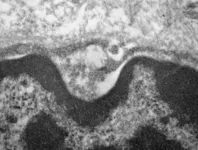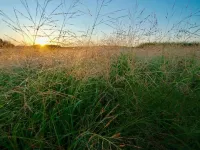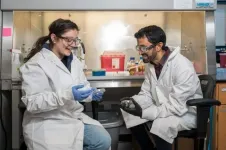(Press-News.org) In Brazil, researchers at the University of São Paulo’s Medical School (FM-USP) have discovered that SARS-CoV-2 infects and replicates in the salivary glands.
Analysis of samples from three types of salivary gland obtained during a minimally invasive autopsy procedure performed on patients who died from complications of COVID-19 at Hospital das Clínicas, FM-USP’s hospital complex, showed that tissues specializing in producing and secreting saliva serve as reservoirs for the novel coronavirus.
The study was supported by FAPESP and reported in an article published in the Journal of Pathology.
The researchers said the discovery helps explain why the virus is so abundant in saliva and has enabled scientists to develop saliva-based diagnostic tests for COVID-19.
“This is the first report of a respiratory virus’s capacity to infect and replicate in salivary glands. Until now it was thought that only viruses that cause highly prevalent diseases such as herpes used salivary glands as reservoirs. The discovery may help explain why SARS-CoV-2 is so infectious,” Bruno Fernandes Matuck, a PhD candidate at USP’s Dental School and first author of the article, told Agência FAPESP.
A previous study by the same group had already demonstrated the presence of RNA from SARS-CoV-2 in the periodontal tissue of patients who died from COVID-19 (more at: agencia.fapesp.br/35675/).
Because SARS-CoV-2 is highly infectious compared with other respiratory viruses, they raised the hypothesis that it may replicate in cells of the salivary glands and hence be present in saliva without coming into contact with nasal and lung secretions. Prior research detected ACE2 receptors in salivary gland ducts. The spike protein in SARS-CoV-2 binds to ACE2 in order to invade and infect cells. More recently, other research groups have conducted studies in animals showing that other receptors besides ACE2, such as transmembrane serine protease 2 (TMPRSS2) and furin, both of which are present in salivary glands, are targets of SARS-CoV-2.
To test this hypothesis in humans, ultrasound-guided autopsies were performed on 24 patients who died from COVID-19, with a mean age of 53, to extract tissue samples from the parotid, submandibular and minor salivary glands.
The tissue samples were submitted to molecular analysis (RT-PCR), which detected the presence of the virus in more than two-thirds. Immunohistochemistry – a form of immunostaining in which antibodies bind to the antigen in the tissue sample, a dye is activated, and the antigen can then be seen under a microscope – also demonstrated the presence of the virus in the tissue. Finally, examination under an electron microscope detected not just the presence of the virus but also its replication in cells and the type of organelle it uses to replicate.
“We observed several viruses clustering in salivary gland cells, which showed that they were replicating there. They weren’t in these cells passively,” Matuck said.
The mouth as direct point of entry
The researchers now plan to see whether the mouth can be a direct point of entry for SARS-CoV-2, given that ACE2 and TMPRSS2 are found in various parts of the cavity, as well as in gum tissue and oral mucosa. In addition, the mouth has a larger contact area than the nasal cavity, which is widely considered the main way in for the virus.
“We’re going to partner with researchers at the University of North Carolina in the United States to map the distribution of these receptors in the mouth and quantify viral replication in oral tissues,” said Luiz Fernando Ferraz da Silva, a professor at FM-USP and principal investigator for the project.
“The mouth could be a viable medium for the virus to enter the body directly,” Matuck said.
Another idea is to find out whether older people have more ACE2 receptors in their mouths than younger people, given the decrease in salivary secretion with age. Nevertheless, the researchers found a high viral load even in older patients, who have less salivary tissue.
“These patients had almost no salivary tissue, almost only fatty tissue. Even so, viral load was relatively high,” Matuck said.
The article “Salivary glands are a target for SARS-CoV-2: a source for saliva contamination” (doi: 10.1002/path.5679) by Bruno Fernandes Matuck, Marisa Dolhnikoff, Amaro Nunes Duarte-Neto, Gilvan Maia, Sara Costa Gomes, Daniel Isaac Sendyk, Amanda Zarpellon, Nathalia Paiva de Andrade, Renata Aparecida Monteiro, João Renato Rebello Pinho, Michele Soares Gomes-Gouvêa, Suzana C.O.M. Souza, Cristina Kanamura, Thais Mauad, Paulo Hilário Nascimento Saldiva, Paulo H. Braz-Silva, Elia Garcia Caldini and Luiz Fernando Ferraz da Silva is at: onlinelibrary.wiley.com/doi/10.1002/path.5679.
Novel coronavirus infects and replicates in salivary gland cells
A study conducted at the University of São Paulo suggests that tissues specializing in saliva production and secretion serve as reservoirs for SARS-CoV-2, magnifying its infectious potential.
2021-07-06
ELSE PRESS RELEASES FROM THIS DATE:
Research enhances understanding of switchgrass, an important bioenergy crop
2021-07-06
Bioenergy crops are an alternative energy source that, unlike fossil fuels, could positively impact the environment by reducing greenhouse gases, soil erosion, and carbon dioxide levels. They can be produced even more sustainably if they are grown on poor quality land unsuitable for food. To make up for the poor land quality, these crops can rely on soil microbes like bacteria and fungi to help them access nutrients and water and store more carbon.
Switchgrass, a native prairie species, is championed as a promising bioenergy crop due to its ability to grow across many climates. ...
Context in science reporting affects beliefs about, and support for, science
2021-07-06
BUFFALO, N.Y. - How the media frame stories about science affects the public's perception about scientific accuracy and reliability, and one particular type of narrative can help ameliorate the harm to science's reputation sometimes caused by different journalistic approaches to scientific storytelling, according to a new study led by a University at Buffalo researcher.
"What our experiment shows is that the way the news media talk about science focuses too much attention on individuals in a way that doesn't accurately describe the way science actually works," says ...
Not enough women and minorities apply for a job? Change the recruitment committee
2021-07-06
Amid calls for racial and social justice nationwide, businesses and educational institutions are grappling with how to adopt more inclusive organizational practices, including more diversified hiring. However, recruitment teams and strategic leaders often blame their lack of a diverse workforce on a lack of diverse applicants. A large study of recruitment data suggests a simple and efficient way of increasing diversity in applicant pools: have more diverse recruitment committees and leadership teams.
The study, led by researchers at the University of Houston's Center for ADVANCING ...
Interleukin-6 antagonists improve outcomes in hospitalised COVID-19 patients
2021-07-06
Findings from a study published today [6 July] in the Journal of the American Medical Association (JAMA) have prompted new World Health Organization (WHO) recommendations to use interleukin-6 antagonists in patients with severe or critical COVID-19 along with corticosteroids.
A new analysis of 27 randomised trials involving nearly 11,000 patients found that treating hospitalised COVID-19 patients with drugs that block the effects of interleukin-6 (the interleukin-6 antagonists tocilizumab and sarilumab) reduces the risk of death and the need for mechanical ventilation.
The study, which was coordinated by WHO in partnership with King's College London, University of Bristol, University ...
Software tool breathes life into post-COVID office airflow
2021-07-06
ITHACA, N.Y. - As offices nationwide spring back to life, interior space designers and architects will soon have an easy-to-use planning tool to place indoor workplace furniture, staff, partitions and ventilation in a manner that maximizes fresh air flow and reduces the risk of airborne pathogens.
The Cornell Environmental Systems Lab in the College of Architecture, Art and Planning will introduce a new indoor module for their existing Eddy3D software, a professional-level airflow and microclimate simulator that can help improve ventilation.
The new indoor module will be released this summer, while the research supporting it will ...
Keeping bacteria under lock and key
2021-07-06
Scientists and engineers are constantly looking for ways to better our world.
Synthetic biology is an emerging field with promise for improving our ability to manufacture chemicals, develop therapeutic medicines such as biopharmaceuticals and vaccines, and enhance agricultural production, among other things. It relies on taking natural or engineered pieces of DNA and combining them in new ways in biological systems, such as microbes, bacteria or other organisms.
According to University of Delaware's Aditya Kunjapur, assistant professor of chemical and biomolecular engineering, as these sophisticated microbial technologies are advanced, scientists need to explore ways to keep these organisms from ending up in the wrong environment.
For example, a bacterium that is good at making ...
Fighting COVID with COVID
2021-07-06
UNIVERSITY PARK, Pa. -- What if the COVID-19 virus could be used against itself? Researchers at Penn State have designed a proof-of-concept therapeutic that may be able to do just that. The team designed a synthetic defective SARS-CoV-2 virus that is innocuous but interferes with the real virus's growth, potentially causing the extinction of both the disease-causing virus and the synthetic virus.
"In our experiments, we show that the wild-type [disease-causing] SARS-CoV-2 virus actually enables the replication and spread of our synthetic virus, thereby effectively promoting its own decline," said Marco Archetti, associate professor of biology, Penn State. "A version of this synthetic construct could be used as a self-promoting ...
Loss of biodiversity in streams threatens vital biological process
2021-07-06
UNIVERSITY PARK, Pa. -- The fast-moving decline and extinction of many species of detritivores -- organisms that break down and remove dead plant and animal matter -- may have dire consequences, an international team of scientists suggests in a new study.
The researchers observed a close relationship between detritivore diversity and plant litter decomposition in streams, noting that decomposition was highest in waters with the most species of detritivores -- including aquatic insects such as stoneflies, caddisflies, mayflies and craneflies, and crustaceans such as scuds and freshwater shrimp and crabs.
Decomposition ...
Perceptions of counterfeits among luxury goods differ across cultures
2021-07-06
ABINGTON, Pa. -- Counterfeit dominance decreases Anglo-American, but not Asian, consumers' quality perception and purchase intention of authentic brands, according to a team of researchers.
"Counterfeit dominance is the perception that counterfeit products possess more than 50% of market share," Lei Song, assistant professor of marketing at Penn State Abington, said. "Counterfeit dominance is a phenomenon especially concerning for the luxury fashion industry as counterfeit luxury fashion brands account for 60% to 70% of the $4.5 trillion in total counterfeit trade and one-quarter of total sales in luxury fashion goods."
Lei and his team conducted four behavioral experiments with 149 participants on ...
How racial wage discrimination of football players ended in England
2021-07-06
Increased labour mobility seems to have stopped the racial wage discrimination of black English football players. A new study in economics from Stockholm university and Université Paris-Saclay used data from the English Premier League to investigate the impact of the so-called "Bosman ruling", and found that racial discrimination against English football players disappeared - but not for non-EU players. The study was recently published in the journal European Economic Review.
In 1995, the so-called Bosman ruling turned the labour market for European footballers upside down, introducing a free transfer ...
LAST 30 PRESS RELEASES:
SIMJ announces global collaborative book project in commemoration of its 75th anniversary
Air pollution exposure and birth weight
Obstructive sleep apnea risk and mental health conditions among older adults
How talking slows eye movements behind the wheel
The Ceramic Society of Japan’s Oxoate Ceramics Research Association launches new international book project
Heart-brain connection: international study reveals the role of the vagus nerve in keeping the heart young
Researchers identify Rb1 as a predictive biomarker for a new therapeutic strategy in some breast cancers
Survey reveals ethical gaps slowing AI adoption in pediatric surgery
Stimulant ADHD medications work differently than thought
AI overestimates how smart people are, according to HSE economists
HSE researchers create genome-wide map of quadruplexes
Scientists boost cell "powerhouses" to burn more calories
Automatic label checking: The missing step in making reliable medical AI
Low daily alcohol intake linked to 50% heightened mouth cancer risk in India
American Meteorological Society announces Rick Spinrad as 2026 President-Elect
Biomass-based carbon capture spotlighted in newly released global climate webinar recording
Illuminating invisible nano pollutants: advanced bioimaging tracks the full journey of emerging nanoscale contaminants in living systems
How does age affect recovery from spinal cord injury?
Novel AI tool offers prognosis for patients with head and neck cancer
Fathers’ microplastic exposure tied to their children’s metabolic problems
Research validates laboratory model for studying high-grade serous ovarian cancer
SIR 2026 delivers transformative breakthroughs in minimally invasive medicine to improve patient care
Stem Cell Reports most downloaded papers of 2025 highlight the breadth and impact of stem cell research
Oxford-led study estimates NHS spends around 3% of its primary and secondary care budget on the health impacts of heat and cold in England
A researcher’s long quest leads to a smart composite breakthrough
Urban wild bees act as “microbial sensors” of city health.
New study finds where you live affects recovery after a hip fracture
Forecasting the impact of fully automated vehicle adoption on US road traffic injuries
Alcohol-related hospitalizations from 2016 to 2022
Semaglutide and hospitalizations in patients with obesity and established cardiovascular disease
[Press-News.org] Novel coronavirus infects and replicates in salivary gland cellsA study conducted at the University of São Paulo suggests that tissues specializing in saliva production and secretion serve as reservoirs for SARS-CoV-2, magnifying its infectious potential.



